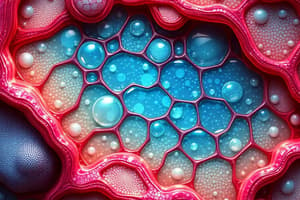Podcast
Questions and Answers
What is a primary function of epithelial tissue?
What is a primary function of epithelial tissue?
- Facilitate movement
- Support body structures
- Control bodily functions
- Protect and absorb (correct)
Which characteristic is NOT associated with epithelial tissue?
Which characteristic is NOT associated with epithelial tissue?
- Continuous sheets of cells
- High vascularity (correct)
- Rapid regeneration
- Presence of apical surface
What shape is associated with squamous epithelial cells?
What shape is associated with squamous epithelial cells?
- Flattened like fish scales (correct)
- Cubical
- Tall and slender
- Columnar
Which epithelial classification is defined by the number of cell layers?
Which epithelial classification is defined by the number of cell layers?
Where is simple squamous epithelium commonly found?
Where is simple squamous epithelium commonly found?
What is the role of the basement membrane in epithelial tissue?
What is the role of the basement membrane in epithelial tissue?
Which primary function is inappropriate for epithelial tissue?
Which primary function is inappropriate for epithelial tissue?
What type of epithelium is characterized by having multiple layers of cells?
What type of epithelium is characterized by having multiple layers of cells?
What is the primary function of simple cuboidal epithelium?
What is the primary function of simple cuboidal epithelium?
Where is simple columnar epithelium predominantly found?
Where is simple columnar epithelium predominantly found?
Which characteristic is shared by pseudostratified epithelium?
Which characteristic is shared by pseudostratified epithelium?
What is the primary role of goblet cells found in simple columnar epithelium?
What is the primary role of goblet cells found in simple columnar epithelium?
What is a defining feature of stratified squamous epithelium?
What is a defining feature of stratified squamous epithelium?
What function does transitional epithelium serve?
What function does transitional epithelium serve?
What distinguishes endocrine glands from exocrine glands?
What distinguishes endocrine glands from exocrine glands?
Which type of epithelium contains microvilli to increase absorption surface area?
Which type of epithelium contains microvilli to increase absorption surface area?
Flashcards
Epithelial Tissue
Epithelial Tissue
Groups of similar cells forming continuous sheets that cover and line body surfaces and cavities.
Simple Squamous Epithelium
Simple Squamous Epithelium
Single layer of flattened cells, facilitating absorption and filtration.
Apical Surface
Apical Surface
Top surface of epithelial cells, facing a body cavity or open space (lumen).
Basement Membrane
Basement Membrane
Signup and view all the flashcards
Avascularity
Avascularity
Signup and view all the flashcards
Squamous cell
Squamous cell
Signup and view all the flashcards
Epithelial functions
Epithelial functions
Signup and view all the flashcards
Cell layers (epithelial)
Cell layers (epithelial)
Signup and view all the flashcards
Simple Cuboidal Epithelium
Simple Cuboidal Epithelium
Signup and view all the flashcards
Simple Columnar Epithelium
Simple Columnar Epithelium
Signup and view all the flashcards
Pseudostratified Epithelium
Pseudostratified Epithelium
Signup and view all the flashcards
Stratified Squamous Epithelium
Stratified Squamous Epithelium
Signup and view all the flashcards
Transitional Epithelium
Transitional Epithelium
Signup and view all the flashcards
Endocrine Glands
Endocrine Glands
Signup and view all the flashcards
Exocrine Glands
Exocrine Glands
Signup and view all the flashcards
Location of Epithelium
Location of Epithelium
Signup and view all the flashcards
Study Notes
Tissue Introduction & Epithelial Tissue
- Human bodies develop from single to multicellular cells, specializing.
- The human body is an interdependent system; failure of one cell group can be catastrophic.
- Cells specialize into tissues, then organs.
- Tissues are groups of similar cells, structured and functioning in a similar manner.
Types of Tissues
- Epithelial: Coverings and linings of surfaces
- Connective: Support (e.g., bone, ligaments, fat)
- Muscle: Movement
- Nervous: Control (e.g., brain, nerves, spinal cord)
Function of Epithelial Tissue
- Protection: Skin protects against sunlight, bacteria, and physical damage.
- Absorption: Lining of the small intestine absorbs nutrients into the blood.
- Filtration: Lining of kidney tubules filters wastes from blood plasma.
- Secretion: Different glands produce perspiration, oils, digestive enzymes, and mucus.
Characteristics of Epithelial Tissue
- Continuous sheets: Arranged like tiles
- Apical surface: Top surface bordering an open space (lumen)
- Basement membrane: Underside, anchoring to connective tissue
- Avascular: Lacks blood vessels; nourished by connective tissue.
- Regenerate quickly: Can repair quickly.
Classification of Epithelial Tissue
- Cell Shape: Squamous (flattened, like fish scales), Cuboidal (cube-shaped), Columnar (column-shaped)
- Cell Layers: Simple (single layer), Stratified (many layers)
- Classification is based on the cell type at the apical surface.
Simple Squamous Epithelium
- Structure: Single layer of flattened cells
- Function: Absorption, filtration
- Not effective protection: Single layer, only absorbs
- Location: Walls of capillaries, air sacs in lungs, forming serous membranes in body cavities.
Simple Cuboidal Epithelium
- Structure: Single layer of cube-shaped cells
- Function: Secretion and transport in glands, filtration in kidneys
- Location: Glands and ducts (e.g., pancreas, salivary), kidney tubules, covers ovaries
Simple Columnar Epithelium
- Structure: Elongated cells with nuclei at same level
- Function: Absorption, protection, secretion
- Special features: Microvilli, goblet cells, producing mucus
- Location: Linings of the entire digestive tract
Pseudostratified Epithelium
- Structure: Irregularly shaped cells with nuclei at different levels, appearing stratified but all reach the basement membrane
- Function: Absorption and secretion and Cilia
- Location: Respiratory and reproductive tracts
Stratified Squamous Epithelium
- Structure: Many layers, usually cuboidal/columnar at the base, squamous at the top
- Function: Protection
- Keratin: Protein accumulating in older cells making the skin waterproof and tough
- Location: Skin (keratinized), mouth, and throat (non-keratinized)
Transitional Epithelium
- Structure: Many layers, base cells are cuboidal/columnar, surface cells vary, changing between simple and stratified form when stretching
- Function: Allows stretching and changing size
- Location: Urinary bladder, ureters, and urethra
Glands
- Single or multiple cells secreting products
- Secretion: Protein in aqueous solution (hormones, acids, oils)
- Endocrine glands: No ducts, release secretion into blood vessels (e.g., thyroid, adrenal, pituitary).
- Exocrine glands: Contain ducts, release secretion onto epithelial surface (e.g., sweat, oil, salivary, mammary).
Shapes of Exocrine Glands
- Branching: Simple (single, unbranched duct) or compound (branched)
- Shape: Tubular (tube-shaped), alveolar (flask- or sac-shaped), tubuloalveolar (both tubes and sacs).
Modes of Secretion
- Merocrine: Released by exocytosis, no change to the gland (e.g., sweat, salivary glands)
- Holocrine: Gland ruptures, releasing secretion and dead cells (e.g., sebaceous glands).
Studying That Suits You
Use AI to generate personalized quizzes and flashcards to suit your learning preferences.



